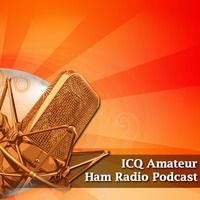 A major problem in the wake of Helene has been broken lines of communications. Cellular...
A major problem in the wake of Helene has been broken lines of communications. Cellular... Reading view
In times of devastation many turn to old school tech to keep communication lines open (North Carolina)
 A major problem in the wake of Helene has been broken lines of communications. Cellular...
A major problem in the wake of Helene has been broken lines of communications. Cellular... ICQ Podcast Episode 440 – UK Ham Fest 2024, Part1
 In this episode, I join Martin Butler M1MRB, Caryn Eve Murray KD2GUT, Edmund Spicer M0MNG, and Ed Durrant DD5LP to discuss the latest Amateur / Ham Radio news. We discussed the following:
In this episode, I join Martin Butler M1MRB, Caryn Eve Murray KD2GUT, Edmund Spicer M0MNG, and Ed Durrant DD5LP to discuss the latest Amateur / Ham Radio news. We discussed the following:-
PRESENTER OPINION : The ARRL elections this year are a sham?
-
Russia and Belarus eligible again for the CQ WW Contest Awards
The feature for this episode is the first part of the ICQ Podcast’s report on the UK Ham Fest 2024.
Catching The Full Wave: Bridge Rectifier On The Oscilloscope
As my ham radio journey takes me on a more formal study of electricity, my home laboratory grows. I remembering purchasing the Tektronix 2465 a few years back on a suggestion of a friend, not having a clue what I was doing with it. I just knew that real electronics enthusiasts had an oscilloscope.
Now that I am crawling my way through the Sedra/Smith’s Microelectronic Circuits tome, I have plenty of reasons to fire up my mushrooming pile of test equipment.
Let’s start with this circuit, the bridge rectifier.

The bridge rectifier is a fairly simple circuit to build, consisting of only four diodes (1N4001 in this case) and a load (10kΩ resistor). In the Multisim sketch above, the device on the left is a function generator producing a 5 volt peak-to-peak 60 Hz sine wave. On the positive half-wave of the signal cycle, the function generator’s positive terminal feeds into node D1/D2 of the four diodes forming the bridge rectifier. This positive signal forward biases D2, allowing the signal to continue on toward the load R1. D1 and D4, however, are reverse biased, and the signal is only able to conduct through D2. On the negative half-wave of the sine signal cycle, the function generator’s negative terminal now feeds a positive signal into node D3/D4. The signal now forward biases D4 and reverse biases D3 and D2. This half signal proceeds through the load R1 in the same direction as the positive half-wave portion of the signal did. All of the electricity conducting through the load in the same direction is considered direct current, as it does not have a component that flows in the reverse “backward” direction (as the original imputted sine wave did). Therefore, the bridge rectifier has done its job of “rectifying” alternating current into direct current.
By placing oscilloscope leads across the load resistor, the desired output of the bridge rectifier can be seen, at least in theory. Below is the Multisim oscilloscope simulation result. The bolded reference line is at zero volts. You will note that this “full-wave” rectifier has produced a waveform that is more or less continuously greater than zero volts. As we will see, this is in contrast to the “half-wave” rectifier, where there is no voltage seen when the originating sine wave enters its negative half.

In my home lab, I went ahead and set up a bridge rectifier on a breadboard, and set out to show its characteristics on my oscilloscope.

Part of the new fleet of test equipment are these two beauties, the Topward 8112 function generator producing a 60 Hz signal shown to be 5 volts peak-to-peak on the oscilloscope. And a Fluke 45 digital multimeter which will come in handy later.

After constructing the circuit exactly as shown in the schematic, I hooked up the oscilloscope across the resistor and found a trace that looked like a half-wave rectifier instead of a full-wave. This pretty much looks like a circuit consisting of an sinusoidal signal traversing through a signal forward-biased diode. There is no inversion of the negative portion of the sine wave, as seen with the full-wave rectifier, rather the negative portion of the wave just turns in to zero volts. In essence, unlike the full-wave rectifier, only half of the original sine wave is “rectified” into direct current. This is NOT what this circuit should look like on the oscilloscope.

Based on some earlier work, I expected though that this is what the oscilloscope would show without a bit of careful consideration. It turns out that this oscilloscope trace is not the result of the circuit malfunctioning, but rather a poor testing design creating a false result.
Remember the circuit diagram. The signal generator produces a signal that enters into the bridge rectifier at two distinct nodes D1/D2 and D3/D4. The signal generator needs to be electrically isolated from the output of the bridge rectifier, which occurs through nodes D2/D4 and D1/D3. Instead, however, the oscilloscope and function generator share a single ground, the earth ground in my house when I plug the unit into the wall. This makes both node D3/D4 and D1/D3 grounded which in essence creates a short circuit across diode D3. Without D3, the circuit now functions as a half-wave rectifier.

The multimeter was used to prove that indeed the oscilloscope and function generator grounds were shared. Everything was unplugged from each device and the digital multimeter was set to resistance. Checking the resistance between the outer shields of the BNC connectors of the oscilloscope and function generator showed, none, indicating a short circuit, and proving that this was the cause of the bridge rectifier’s apparent malfunction.
In order to fix this issue, I checked to see if my new TekPower TP-3003D-3 power supply shared a common ground as well. It did not! There were several megaohms of resistance between the ground terminal of the supply and the generator. So, I connected the oscilloscope probe ground and the function generator ground to one of the negative terminals of the power supply and checked the output waveform. It was still not correct.

I had one last trick up my sleeve. I declared the function generators ground as the common reference ground of the circuit. I attached one oscilloscope probe to one side of the load resistor (the top trace) and the other oscilloscope probe to the other side of the load resistor (the bottom trace). I attached the oscilloscope probe ground leads to the function generator ground. The results are shown in the oscilloscope trace below.
In essence, I can see that the top trace is displaying a half-wave rectifier. The bottom wave is showing another half-wave rectifier out of phase with the top trace. In fact, this bottom trace has been inverted, and this waveform now appears upside-down with the humps going upward, when really they would be going downward with negative voltages.

However, the inversion of the second signal is important, because now I can do math with the oscilloscope. Take a look at the third row of controls on the scope below. First I want to “Chop” the displayed signal as this will allow us to see the waveforms better. I have already inverted the signal. Now I want to add the first (upright) and second (inverted) channels together, essentially performing a subtraction function.
Revisit the image of the oscilloscope display above, and you can see the middle trace is now showing a full-rectifier. The middle waveform in the mathematical operation of Ch1 – Ch2 as performed by the oscilloscope.

And sure enough, when you take a voltage reading with the multimeter across the load resistor, you can see a 1.8 V output of direct current. Woo hoo!

I used the new AI image feature on this WordPress site to prompt a proud scientist overlooking the display of a full wave rectifier on his oscilloscope. So darn goofy! My favorite part is the Hollywood vanity lights just like in a professional lab! It is also hard to tell exactly why he is so proud given those results…

It is not surprising that I have a interest in test equipment. Learning the nuances, limitations, and intricacies of testing is paramount, or else you can make what I would refer to in my other life as iatrogenic errors. This little experiment is perfect for showing how something that works exactly as it should can be deemed malfunctioning due to misinterpretation of a lab test. While getting it wrong with this device in my little electronics laboratory is inconsequential, bad testing in the real world can be disastrous.
So the lesson here? Always look for that common ground.
So far away,
KM1NDY
Getting started with Bunkers on the Air
I’ve heard about it before but only just looked into bunkers on the air (or UK BOTA). Turns out there are a lot of sites around and good way to get out and about, use the radio, explore your local region and maybe learn a little bit of history.
Here’s a list of useful sites to get you going:
- Main site
- Database
- Maps
- The Google Map didn’t appear for me, but the OS map is nice, or use the combined on below:
- Combined awards map
The main rules are:
- Be within 1000 m of the bunker location (with the right permissions etc.)
- Qualify the bunker with 25 HF contacts or 10 VHF+ contacts
I’d recommend joining the WhatsApp group listed on the website, and you’ll get invited to the spotting group too.
I was surprised by the number of bunkers locally to me, especailly compared to doing SOTA activations and having to drive at least an hour to get anywhere!
I’ve not activated one yet but there appear to be plenty that have never been done near me.

Radio Prop on Seth Myer’s Show
Logs 6 Oct 2024
5843 0850 Radio Akenzo (tent). SINPO 44433.
6020 0820 Radio Casanova. SINPO 54444.
6160 0845 Skyline R Germany via Shortwave Gold. SINPO 34433.
6285 0833 Weekend Music Radio. SINPO 54444.
6300 1115 Weekend Music Radio via Kiss AM. SINPO 44433.
6315v 1350 Radio Markies. SINPO 44433. Drifting downwards
6317 0828 Radio Markies. SINPO 34433.
7205 0904 Radio Pamela. SINPO 34433.
11675 1058 Radio JVG. SINPO 34433.
Carlos’ Illustrated Radio Listening Report and Recording of Radio New Zealand (October 6, 2024)
8m QRP FT8 (Sunday)
Although my 2.5W 8m FT8 has been on since just after breakfast, no spots yet.
UPDATE 0926z: Just WESSEXSDR (267km) has spotted me.
ICQ Podcast Episode 440 – UK Ham Fest 2024 Part1
How old tech is being used to remotely help in wake of Helene (North Carolina)
 From the moment Hurricane Helene hit the mountains of North Carolina, emergency responders started heading...
From the moment Hurricane Helene hit the mountains of North Carolina, emergency responders started heading... How to stay in touch when the grid goes down: ham radio, Wi-Fi, and other lifelines during disasters (Georgia)
 We were spared, but many of our friends were not. You know what I’m talking...
We were spared, but many of our friends were not. You know what I’m talking... Sunday plans
Later I expect to go on 8m QRP FT8 and 10m QRP WSPR again.
Sunspots - Sunday October 6th
Solar flux is 277 and the SSN 173. A=7 and K=2.
via Hackaday: Where is the End of DIY?
 Al and I were talking on the podcast about Dan Maloney’s recent piece on how...
Al and I were talking on the podcast about Dan Maloney’s recent piece on how... 
 Read more at ARRL.org
Read more at ARRL.org 









